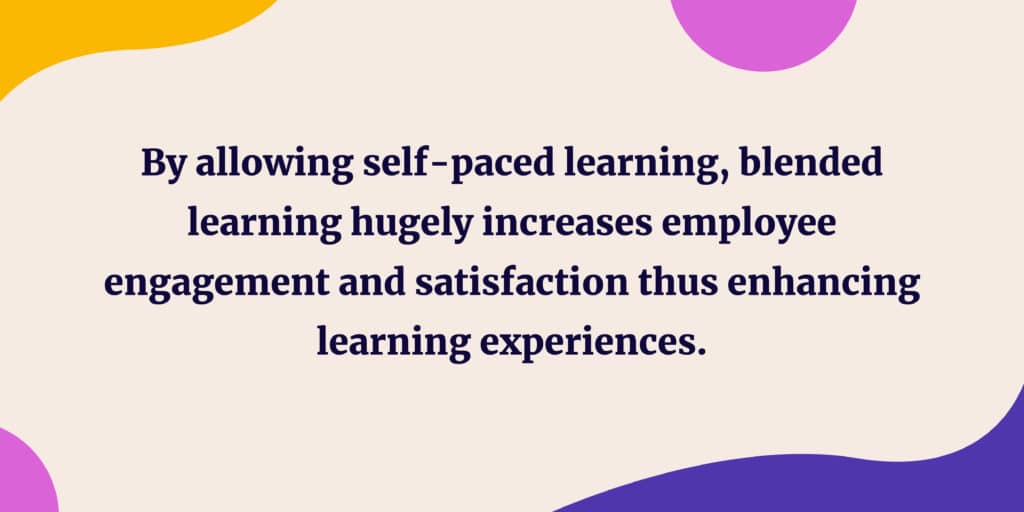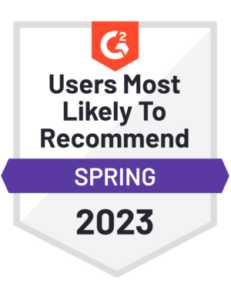Consider this…
If you’re a course instructor or avid learner, it’s highly likely that the pandemic has messed things up on your end. Maybe you’ve even considered plunging into the online space to ramp up your corporate training sessions. But what if there’s a sustainable solution to your challenges? Worry not! The blended learning approach can solve your woes. It’s a learning method that involves a mix of both synchronous and asynchronous learning. Ideally, blended learning aims at maximizing the strengths of the learning approach.
Purpose of blended learning
As an all-encompassing method, blended learning offers much in the way of learning flexibility and convenience. By allowing self-paced learning, blended learning hugely increases employee engagement and satisfaction thus enhancing learning experiences.

Models of blended learning
Blended learning can be further broken down into a few different models, which utilise the synchronous/asynchronous elements in different ways. However something they all share is utilizing synchronous learning time to develop, expand on, and clarify the materials and learning done independently. Have a look:
Rotation model
In this model, learners switch between small synchronous and other asynchronous learning modalities in line with the instructor’s discretion over the course of a single session. The reason it’s referred to as rotational is because the learners regularly rotate their focus from independent study, to group sessions, to instructor lead comprehension sessions. This can be good approach if there are several subtopics to cover. Imagine a SETM course, learners may have a small independent session to learn about say, a particular computer program or tool to be used, then move to a group session or virtual meet to discuss and share with one another, and finally the group would be joined by the instructor to check on progress and understanding, before moving on to the next tool or program, where the process repeats itself.
A great feature of this model is that learners engage in self-directed practice before delving into synchronous sessions. It is quite controlled in terms of schedule and ensures all learners are up-to-speed on all elements to be covered.
Face-to-face driver model
This model is the closest to the typical classroom structure. The only difference is that online instruction is given to some learners on a case-by-case basis. It is ideal for students who are struggling to study beyond their current levels. The self-paced online approach enables them to catch up with the rest of the learners and progress effectively. Ideally learners spend the majority of their learning time studying independently but have scheduled group sessions and the ability to contact instructors when they feel the need or are struggling. In this model, digital environments can be used to deliver learning materials and provide additional support and supplement synchronous study time.
Flipped classroom
The flipped classroom model has become an increasingly prominent feature in post secondary and professional learning situations. Essentially, it divides the learning process into 2 distinct sections input and output. This means that in order to learn something, learners require both the chance to receive and absorb new information and the opportunity to express and develop this understanding through discussion and activity with their peers and instructor. It further assumes that learners are capable and motivated enough to handle the input phase independently. So in the case of online learning this means providing all the study materials and resources (and even activities) prior to any kind of virtual or face-to-face session. Learners then arrive at the group session informed, ready to discuss what they have understood and perhaps what questions still remain.
The flipped classroom model strikes a nice balance of learner autonomy while still keeping a degree of scheduled accountability. For the same reason it is also motivating for learners because while they can study at their own pace there is still the expectation that they will arrive prepared to the group sessions and be able to make contributions. It can even be jazzed up by assigning different learners slightly different materials related to the topic, this way they bring different insights and only get a more complete picture of the topic by sharing their insights and listening to those of others.
Because of this flexibility and balance the flipped classroom is quickly becoming the go-to method for effective learning.
Enriched virtual
Enriched virtual blended learning bears a lot of resemblance to the flipped classroom model. The main difference here is that in the enriched virtual model, synchronous meet sessions are not a scheduled, mandatory part of the program. Instead, learners complete their course work online, only meeting with instructors intermittently or as needed. This model provides an even greater degree of learner autonomy at the cost of reduced oversight. With motivated, and perhaps busy learners this may be an advantage. Using an online platform such as Claned which offers tracking and analytic tools can compensate for reduced oversight and allow for a degree of insight into learner progress and behaviour. Interventions can then be made if it appears some learners are falling behind.
Project/Problem based
As the title suggests, project/problem based blended learning revolves around learners completing a specific project and/or solving a problem. Often in this style of blended learning synchronous sessions are held at the beginning and end of the course to introduce the project/problem and to evaluate the finished product/solution. It is also common that midway sessions may be held with the instructor either individually or as a group and that instructors be available throughout the process for support when needed or requested. This is another model gaining wide-spread usage in the post secondary and professional fields. Projects/problems often mimic or take on real world challenges making the learning relatable and useful in the eyes of learners. In professional settings learners may even bounce back and fourth between their project and working situations, allowing them to immediately apply their learning to their professional activities.
Examples of blended learning approaches by top companies

Some top companies like Ticket Master and CDW turned to blended learning as a viable means to conduct their corporate training sessions.
Ticketmaster
Ticketmaster offered a practical example of blended learning. Some noticeable gaps in their customer service led them to consider blended learning. They used synchronous live training coupled with electronic support tools for corporate training. The strategy entailed a combination of self-paced learning and real-world application that yielded impressive results.
CDW
On the other hand, CDW’s lack of a unified user experience caused their shift to synchronous corporate training. To empower both their remote and in-office employees, they leveraged learning resources and tools to meet their objectives. The employees then applied the information to the real world. The employee’s application of hands-on experience moved the company’s objective up a notch.
With these companies in mind, rest assured that a blended approach is a viable option. You can actually ace your corporate training sessions and empower your employees!
Advantages and disadvantages of blended learning
With COVID-19 in the picture in the current times, most companies have considered the hybrid learning approach. It involves employees attending – in due part – synchronous learning and spending the remaining time learning independently from their remote locations. Similar to other learning methods, blended learning has unique advantages and disadvantages.

Time effectiveness

A blended learning approach can enable instructors to quickly reach as many learners as possible thus hugely saving time. More so, with the recordings, learners left behind can easily catch up with the rest.
Instructor-learner engagement
Blended learning vies for engagement and prompt communication in every aspect. By sifting through the online blended courses, learners can engage with their instructors, ask questions and seek clarification. When it comes to engagement, don’t fret! Claned’s interactive and efficient design features can hugely maximize learner engagement.
Flexibility
Since blended learning leverages both digital technologies, learners can easily choose new learning modalities that best suit them. The self-paced or group-paced arrangements give learners a chance to seek knowledge flexibly and gain as much information as they can.

Efficiency and productivity
By studying online, learners can spend less time while at the same time ramp up their productivity. They can also practice what they learn in real life. Such integrated learning experiences tagged onto blended learning provide a solid foundation for efficiency, productivity, and ultimately success.
Learner autonomy
Blended learning not only gives learners control over their time, but it also gives them a chance to explore information on their own and consult their instructors. This lays the groundwork for learner autonomy and enhances deeper understanding.
While blended learning gives learners freedom, it also places a sense of accountability or responsibility on them to have completed the required independent work prior to synchronous sessions.

That way, they may make meaningful contributions. The advantage to the blended model is that learners are responsible to “do the work” and can then use the face to face time for the expansion and development of ideas and concepts, as well as opportunities for peer learning.

High maintenance cost of technological infrastructure
Setting up new technology for blended learning is not a walk in the park. In addition to seeking out infrastructure, you’ll need to hire IT experts to set up and maintain the infrastructure. Your budget may vary depending on your company’s size. But all said and done, the good thing is that once things are set in motion, the situation gets better as time goes by.
The need for technical know-how
After setting up the technology, one more milestone you have to surmount is training your employees on how best to use the tools. But what if they find it hard to accept it, or learn? This is something you need to consider while pondering over the blended approach as an instructor.
Plagiarism issues

In a digital environment, it’s downright difficult to completely keep plagiarism at bay. The instructor or students may rely on unreliable online sources and thus gather inaccurate information.
Tips to maximize teaching with blended learning
As a course instructor, there are some practical tips and tricks you can use to make their blended courses more effective.
Simplicity
As a corporate trainer, you should come up with blended courses that are valuable, yet simple for your employees. Regardless of being simple, the courses should be practical for your learners to easily grasp the information.
Stick to a schedule that works

Your schedule can be the reason why your blended courses fail. To benefit all learners, instructors should provide them with the required schedules so that they won’t miss out on critical information. Instructors should also consider the learners’ feedback to make the learning process more fruitful. Also, instructors should include deadlines for milestones (e.g., complete module 1 by x date) again this adds accountability and helps to keep learners on track while allowing them to study at a time and pace which suits them.
Flexibility
Instructors should also strive to find the right balance between synchronous and asynchronous learning for learners. While digital learning is a great approach, it might not work for all learners. Instructors should therefore deliver content that best suits their learners’ needs.

To wrap up, the blended learning approach is a great way to educate, engage and empower your employees. With this roundup information, your corporate training sessions will definitely tick!







